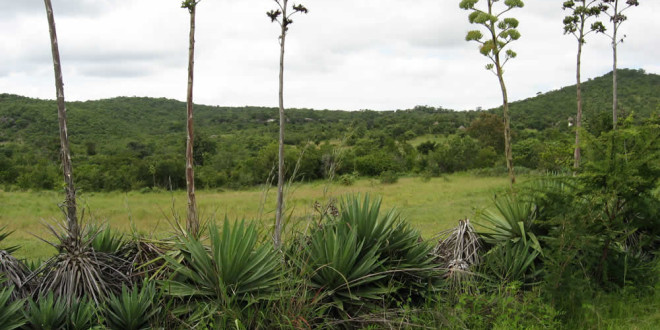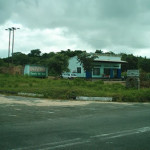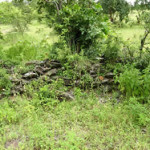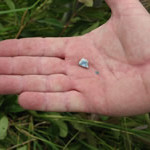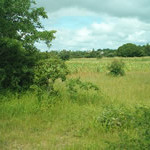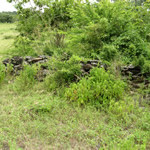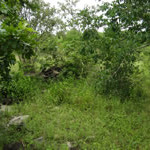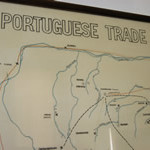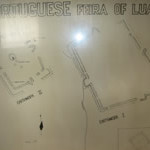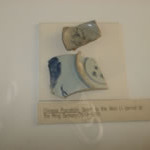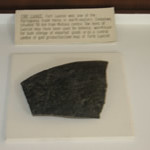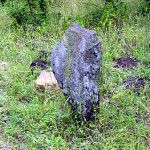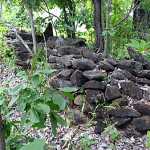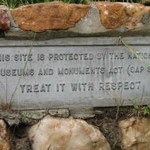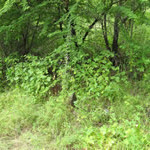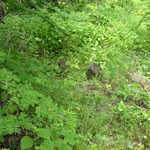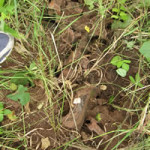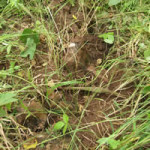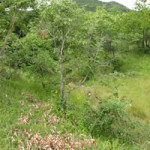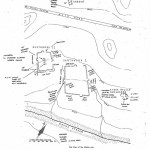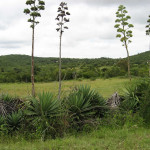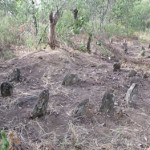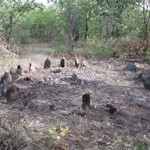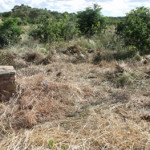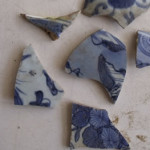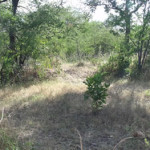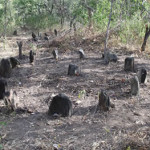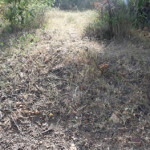Written by Chris Dunbar. All pictures are copyright by Chris Dunbar.
The Fort of Luanze, where the Portuguese hold a market, is in the lands of Mocaranga, forty leagues from Tete…..this fort has a church, served by a dominican friar who administrates the sacraments to the christians who dwell there or pass through. Pedro Barreto de Rezende, 1634.
I then went to Luanze which is about 450 km’s from the Piringani site and about 20 km’s short of the Mozambique border. I had with me a member of the Department of National Monuments as a guide and facilitator.
The remains of the houses built by the Portuguese traders are no longer visible but are indicated by a series of stone markers placed by the archaeologists that excavated the site in the 1960’s. The stone walls built by the local natives that co habited the site with the Portuguese traders are still very evident and the stream that started the trade in alluvial gold, was just evident. It was very difficult to picture the site as the vegetation has taken over but it was possible to walk along the walls that were built as barricades and protection. While in the trade square it was relatively (and surprising so) easy to pick up trade beads and shards of Chinese pottery that the Portuguese used to barter for gold and ivory.
Once you crossed the tar sealed road at the modern way stop (Masarakufa) it took a bit of looking to locate the site of the Dominican Church, but did find it as it is marked by a plinth placed by the Department of National Monuments. It is regrettably in a very poor state of repair, I had to clear some of the bush and grass as it was over my head, to find the foundations. The floor while once compacted and level is far from that today, the walls are only inches high but it is still possible to see the outline of the wooden poles imprinted into the mud, that was used for the walls and support structures for this church in 1634, it was incredible.
In Mtoko there is a little museum built to house the artefacts un-earthed at the Luanze Feira.
I attempted to go through Luanze to get to Makaha but there is no viable route any more so I tried to go via Kamoto but I was advised that the route was too long and arduous for the time I had allocated to this visit.
- Modern day way stop (Masarakufa) at the site, the church is that side of the road the market is on the side from where I took the photo. Luanze, Zimbabwe. Author and Copyright Chris Dunbar
- Luanze, native sections of the walls that have survived. Author and Copyright Chris Dunbar.,.,
- What I collected in the space of a metre or so. Luanze, Zimbabwe. Author and Copyright Chris Dunbar
- The trade grounds today. Luanze, Zimbabwe. Author and Copyright Chris Dunbar
- Native sections of the walls that have survived. Luanze, Zimbabwe. Author and Copyright Chris Dunbar,
- Native sections of the walls that have survived. Luanze, Zimbabwe. Author and Copyright Chris Dunbar,
- Sketch of the trade routes and settlements forts ferias. Mtoko Museum. Author and Copyright Chris Dunbar
- Archaeological drawings. Mtoko Museum. Author and Copyright Chris Dunbar
- Chinese Pottery found at the site. Mtoko Museum. Author and Copyright Chris Dunbar
- Finds. Mtoko Museum. Author and Copyright Chris Dunbar
- Grave marker. Luanze, Zimbabwe. Author and Copyright Chris Dunbar
- Native sections of the walls that have survived. Luanze, Zimbabwe. Author and Copyright Chris Dunbar
- Plinth to mark the market fair site. Luanze, Zimbabwe. Author and Copyright Chris Dunbar
- Markers placed to indicate were the Portuguese traders’ houses were. Luanze, Zimbabwe. Author and Copyright Chris Dunbar,
- Markers placed to indicate were the Portuguese traders’ houses were. Luanze, Zimbabwe. Author and Copyright Chris Dunbar,.
- Native sections of the walls that have survived. Luanze, Zimbabwe. Author and Copyright Chris Dunbar, (3)
- Native sections of the walls that have survived. Luanze, Zimbabwe. Author and Copyright Chris Dunbar, (4)
- The market fair (feira) outer wall. Luanze, Zimbabwe. Author and Copyright Chris Dunbar
- Archaeological drawings for Luanze settlement. Photo © by Chris Dunbar
- The outer trade grounds. Luanze, Zimbabwe. Author and Copyright Chris Dunbar
Revisited Luanze and gained permission to do some clean up/restoration on the site.
I worked with one local African with an axe and a grass cutter it took us the whole day to clear the church site, we cut the grass and cut the trees then killed the stumps.
In the Earthwork 2 around the remains of the three Portuguese houses we cut the grass and removed the trees, we tried to remove the ant mounds and lift some of the fallen stone markers but time was now running short.
The fact that two of us cleared and cleaned these two small areas probably means that the site will remain visible for a number of extra years.
Earthwork 1 the larger of the two I was not able to do anything with, I did walk over to visit it but as Earthwork 2 has more tangible visual remains decided to spend my time attempting to preserve those remains.
- The marker stones from where the Portuguese built their houses, daga mud with pole imprints is still scattered on the ground. Luanze, Zimbabwe. Author and Copyright Chris Dunbar.
- The marker stones from where the Portuguese built their houses, daga mud with pole imprints is still scattered on the ground. Luanze, Zimbabwe. Author and Copyright Chris Dunbar
- The site of the Church after we cleared the trees and grass. Daga mud with pole imprints was very visible. Luanze, Zimbabwe. Author and Copyright Chris Dunbar
- Beads that were collected while we did the clean up and from what the children brought us while we did the clean up. Author and Copyright Chris Dunbar
- Ceramics Blue on White that we found while clearing the site around the Portuguese houses. Luanze, Zimbabwe. Author and Copyright Chris Dunbar
- Photo of the Eastern Entrance on Earthwork 2. Luanze, Zimbabwe. Author and Copyright Chris Dunbar
- The marker stones from where the Portuguese built their houses, daga mud with pole imprints is still scattered on the ground. Luanze, Zimbabwe. Author and Copyright Chris Dunbar..
- Photo of the Eastern Bastion on Earthwork 2. Luanze, Zimbabwe. Author and Copyright Chris Dunbar
BIBLIOGRAPHY:
– Ferreira, A. Rita “African kingdoms and alien settlements in Central Mozambique (c. 15th-17th Cent.)” 172 pp. Departamento de antropologia, Universidade de Coimbra, 1999, Coimbra, Portugal.
– Garlake, P. S. ” Seventeenth century Portuguese earthworks in Rhodesia” In: “South African Arch. Bull.” n° 84, 1966, pp. 157-170
– Newitt, M.D.D. “Portuguese settlement on the Zambese: Exploration, Land Tenure & Colonial Rule in East Africa” 434 pp. Maps, illus.& plates. Longmans, 1973, London, UK.
– Rea Francis, W. “The economics of the Zambezi missions, 1580-1759” 189 pp. Institutum Historicum S. I., 1976, Roma, Italia.
 Colonial Voyage The website dedicated to the Colonial History
Colonial Voyage The website dedicated to the Colonial History
